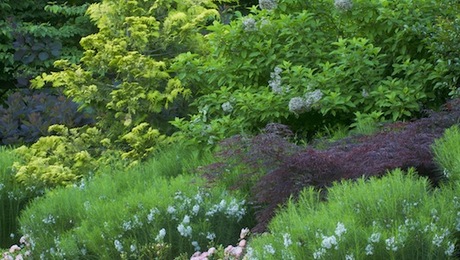
Photo: Paul Zimmerman Roses
In our previous post on rose history, we learned that roses in the United States were being grown mostly for their ability to produce long-stem cut flowers—often to the determent of garden characteristics such as attractiveness of shrub, disease resistance, and even hardiness. But this was not always the case in other countries.
Many European rose-breeding firms continued to keep their garden rose and exhibition/cut-flower lines very separate. They bred roses for the cut-flower industry in addition to a totally separate line of garden roses. The German firm of Kordes and Söhne is a prime example, as is the French firm of Delbard. And some, like Peter Beales Roses in the UK, simply bred only garden roses. But these garden roses were mostly confined to Europe, where the line between them and cut-flower/exhibition varieties was kept fairly distinct. In addition, Europe and most of the rest of the world have always had an aversion to chemicals for the home market.
In the latter part of the 20th century as the United States became more environmentally aware, many chemicals were taken off the market. While some fine hybrid teas were able to thrive without them, many that could only be grown with now disappearing chemicals began to flounder. Since those roses had been marketed and sold at the expense of the true garden roses, it meant that many a home gardener was suddenly faced with a plant that was difficult to grow, wouldn’t flourish, and in many instances died off within a few years. Sound familiar?
Roses began to get the reputation as being fussy, weak, and needing a great deal of care. Suddenly June Cleaver in her pearls was our grandmother slaving over her roses, and we didn’t want to have to work that hard!
That gardeners were beginning to look for easier-to-grow roses is evidenced in the resurgent interest in the old garden roses during this time. Old garden roses had a reputation for being disease resistant and easy to grow. They had earned this reputation because over time, the poor ones had disappeared and the stronger ones had survived. I suspect that in 100 years the hybrid tea class will have gone through the same process and that someone reading this will wonder what the fuss was all about!
In the 1990s, the David Austin Roses took flight in this country. They not only had an old-fashioned look and could be planted among other plants, but they also had fragrance. In their own way, they reintroduced the concept of garden roses as flowering shrubs to the United States. They were marketed as garden roses, and once again the line between garden roses and cut-flower/exhibition roses reemerged in the United States.

















Comments
Log in or create an account to post a comment.
Sign up Log in